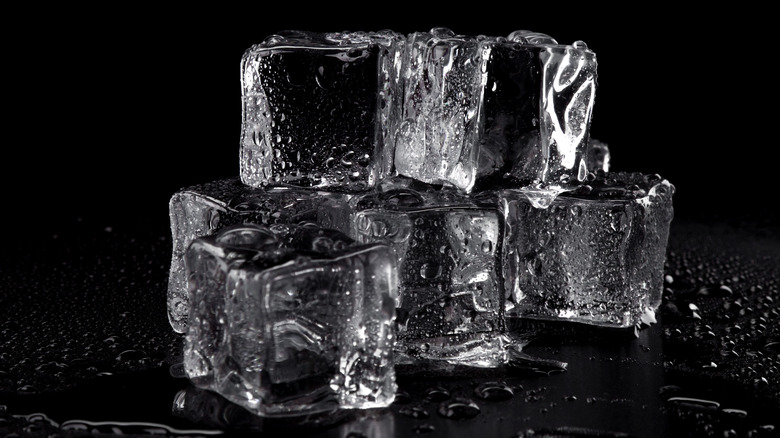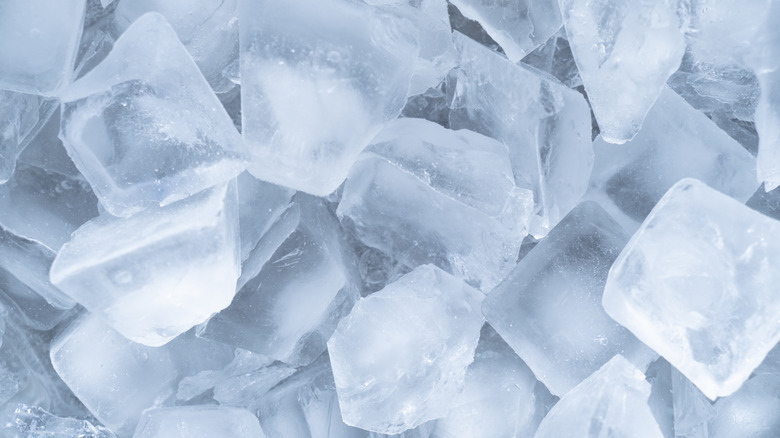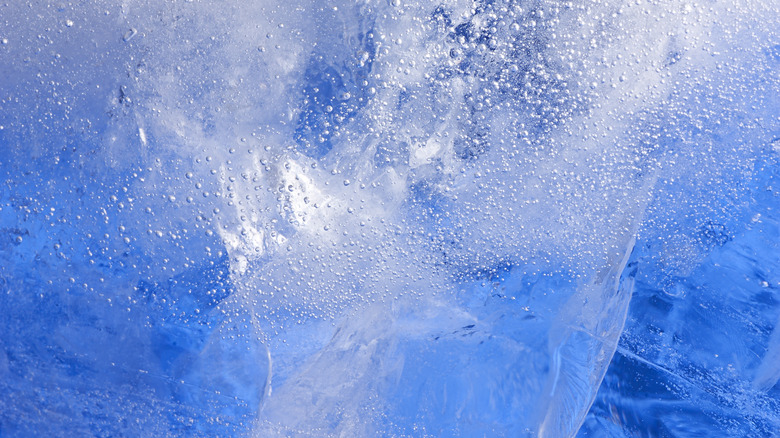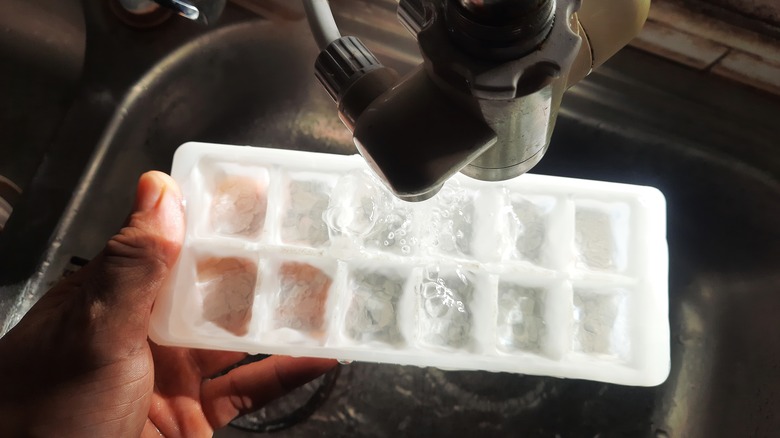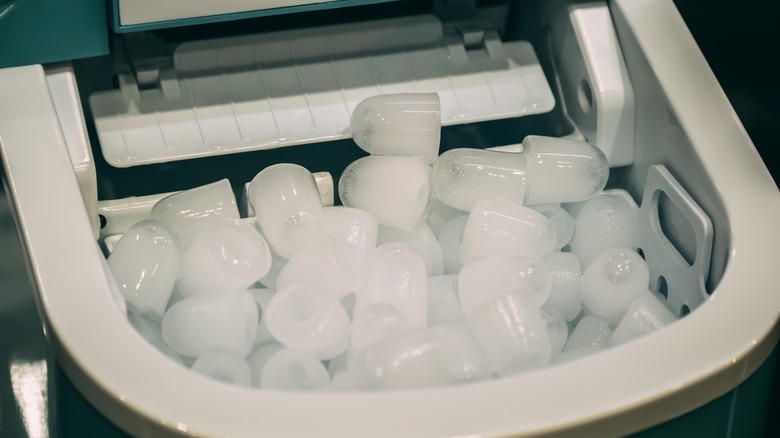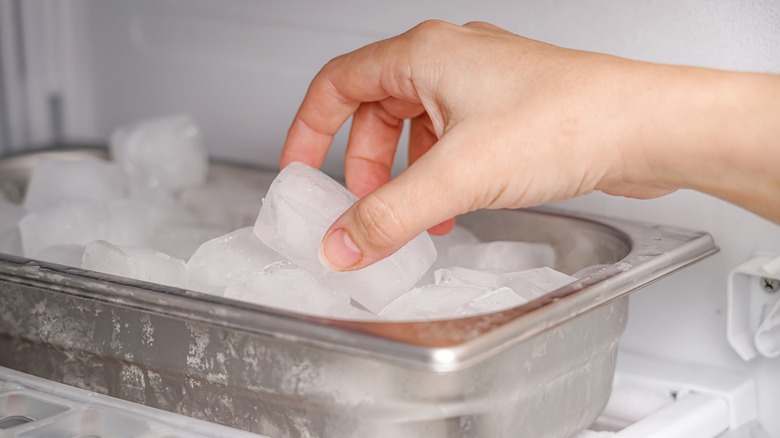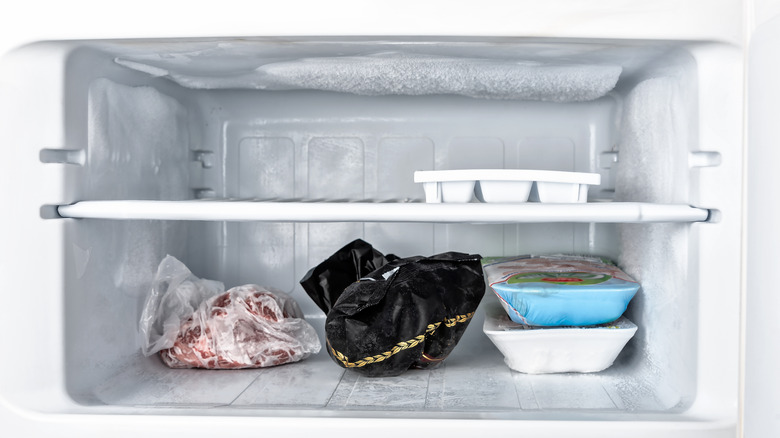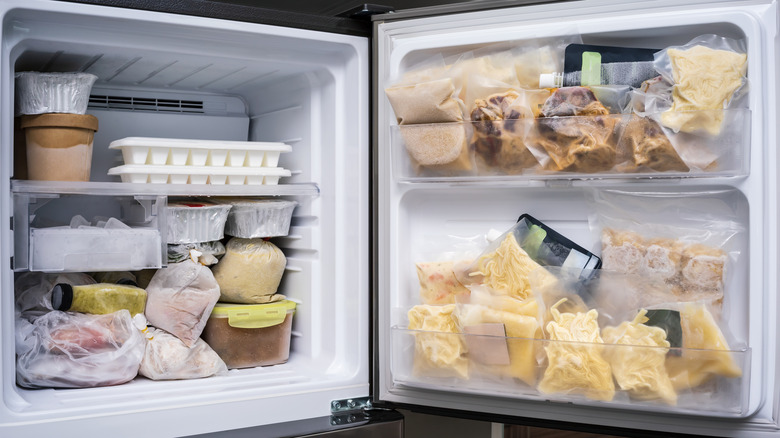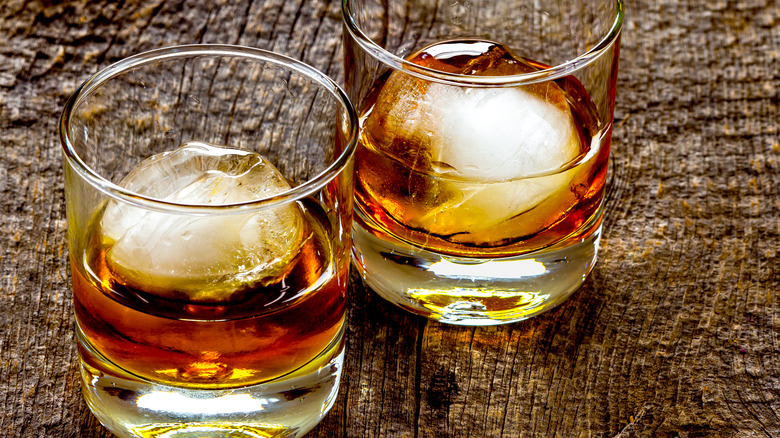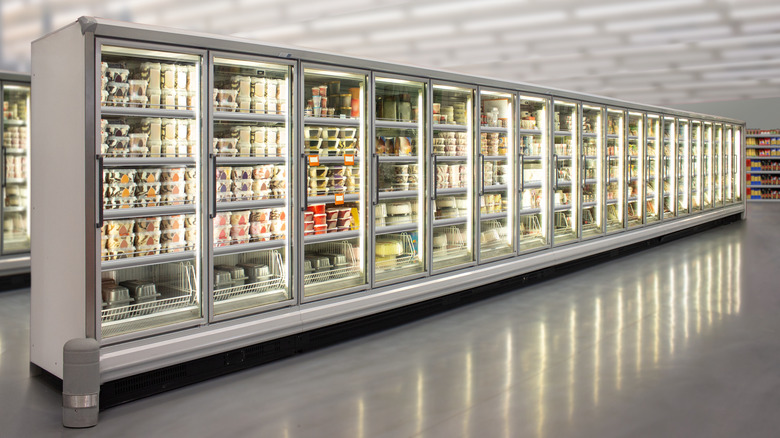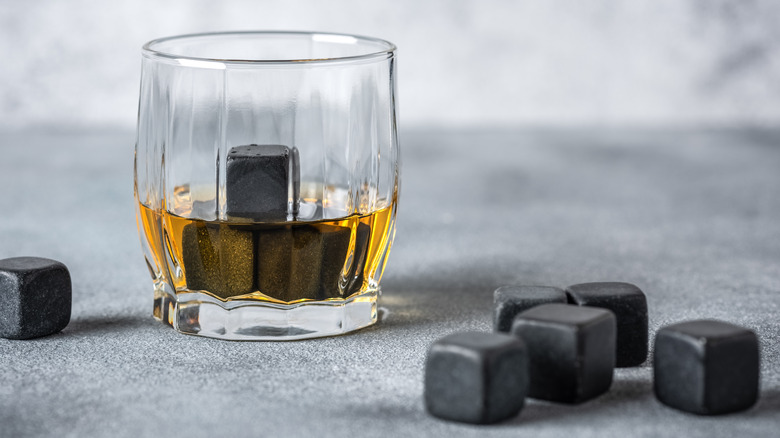Expert Says You're Probably Making 10 Big Mistakes With Ice Cubes
Nothing makes a day feel like summer quite like a frosty drink, with ice cubes clinking against the sides of a glass beaded with tiny droplets of condensation. In our comfy modern world, ice is cheap and abundant — so much so that many of us probably don't think twice about freezing some to drop into our drinks. In a few ways, this can be a big mistake in itself. Ice matters much more than most people may realize, and mistakes while making it can have unpleasant effects on the aesthetics of your drink, its flavor, and even your health. Everything that goes into your glass is part of the drink. If you're using high-quality ingredients for your drinks, it feels like a waste to spoil them with poor-quality ice.
As a former research scientist, I know very well just how complicated ice can be, although admittedly most of the ice I studied professionally was in interstellar space. On the other hand, as a former bartender and long-time amateur mixologist, I know exactly how important ice can be in a drink. When talking about ice, it's easy to go into advanced techniques used by professionals, like directional freezing, but I'm going to focus on the basics here, with the mistakes most of us might be making with our ice. And a few mistakes are all too easy, some of which we may not even realize we're making.
1. Mistake: Making cloudy ice cubes
A lucky few of us live in places with pure, high-quality water, fresh from nearby springs or reservoirs. Everyone else, however, likely has tap water that's full of dissolved minerals, like calcium and magnesium carbonates. In other words, hard water, coming from groundwater sources naturally full of rocks like limestone. In the U.S., roughly 85% of people have hard tap water, particularly around Florida, the Midwest, and Northern Texas. It isn't bad for your health, and may even be a good source of dietary calcium, but it can also give an unpleasant taste to drinks and make for cloudy ice cubes.
If you've ever wondered why your home-frozen ice cubes don't look as crystal clear as the ones you're served in bars, hard water is most likely the cause. Basically, no matter how clear the water may look coming out of the faucet, those dissolved minerals won't stay dissolved when the water freezes. The technical term for this is precipitation, as minerals form into fine solid particles trapped in the ice. The result is murky-looking ice that may leave a chalky residue behind in the bottom of your glass.
As well as the aesthetics, hard water can noticeably affect a drink's flavor, particularly in more mild-tasting drinks like iced green tea. Fortunately, there are a few easy solutions. Using a filter is a simple and effective way to soften your water. To make neutral-tasting ice cubes, you can even try freezing distilled water.
2. Mistake: Making bubbly ice cubes
Another way to make your ice clearer is to boil it before freezing it. This can also help to remove minerals, usually leaving them on the inside of your kettle as coarse white limescale, but boiling water also has another benefit. It can remove dissolved gas, too.
If you look at home-frozen ice cubes, you'll usually see that they're full of bubbles. This is because all water, even bottled, contains dissolved gas from the air. When the ice freezes, that gas precipitates out of solution, just like the minerals do, leaving the center of your ice cubes all bubbly-looking. Over time, water will always dissolve gasses, particularly oxygen, which dissolves easily in water. When you boil water, you might notice bubbles forming in it long before it reaches boiling point, because air is less soluble in hotter water. Boiling the water will deaerate it, meaning it'll have much less dissolved gas than usual, and it'll take time for more air to dissolve into it again.
In other words, if you boil your water first and then leave it to cool before using it to make ice, your ice cubes will be a lot clearer — although they're still unlikely to be perfectly clear. This is purely for aesthetics, as those little air bubbles won't have any effect on your drink. Still, if you're hosting a party, it can be a nice touch to pay attention to the look of the drinks you're serving.
3. Mistake: Not cleaning your ice cube trays
When was the last time you cleaned your ice cube trays? And I don't mean giving them a quick rinse; I mean giving them a thorough deep clean. Over time, ice cube trays can start to pick up odors, and these can easily be transferred into your ice. Typically, these trays are made from plastic or silicone. Being flexible makes it convenient to remove the ice once it's frozen, but as anyone who's ever used plastic storage containers knows, most plastic has a bad habit of picking up unwanted smells. If you ever use ice cube trays to freeze minced garlic or fresh herbs for your cooking, be sure to never use the same trays to make ice!
The scientific reason is that, on a microscopic level, the molecules of plastics and silicones are like bundles of long, twisting threads. Other molecules, like scents and oils, can become tangled up inside them, taking time to find their way back out. This is why, even when you wash a plastic container thoroughly with soap and water, it can sometimes still carry lingering smells or discoloration. Even worse, harmful bacteria can live happily inside ice cube trays, too, so it's a good idea to sanitize them regularly. If any of your trays are starting to show their age, it may be worth cutting your losses, throwing them out, and getting new ones.
4. Mistake: Not cleaning your ice maker
Keeping an ice machine in your home can be a handy way to make sure you always have a refreshing supply of ice in the hotter months of the year. However, it's very important to clean your machine regularly. This isn't just important for the look or flavor of your ice cubes — it's also important for your health.
Even restaurants can be prone to not cleaning their ice machines thoroughly enough. In the worst cases, this has led to outbreaks of food poisoning in the past. The refill chutes and drip trays in ice machines can easily grow mold and bacteria, including nasty things like salmonella, so it's important to check your ice machine regularly. If anything appears slimy, or if you notice any brown or pink discoloration, it's a sign you should clean it immediately.
Using hard water in your ice machine can leave behind limescale. This can gum up your machine, but it can also be a habitat for bacteria to grow, so it's best avoided. Ideally, you should try to use only filtered water to prevent limescale as best you can, but it's still a good idea to descale your machine regularly. Limescale removers are available to buy, but these aren't really necessary. A 50:50 mixture of water and white vinegar will do the trick. Personally, I like to use lemon juice to remove limescale. In case it leaves behind any lingering flavor, it'll be more pleasant than vinegar!
5. Mistake: Keeping your ice open in the freezer
Many of us freeze ice in an open ice cube tray and then simply leave it there until it's ready to use, but this isn't a great idea. Much like the trays themselves (or any cupboard in your home, for that matter), your freezer can slowly pick up smells over time, and those smells can be absorbed by your ice cubes. This will likely vary depending on what kind of food you keep frozen, how it's stored, and how regularly you're able to defrost and clean your freezer out.
Ice can pick up odors through a process called solid-state diffusion. All of the water molecules in ice are constantly jostling against each other, and the molecules that cause odors can become trapped among them, working their way into the ice itself. The result is smelly ice, and no one wants that.
The solution to this one is pretty simple. Wait until the ice is frozen, pop the ice cubes out of their tray, and put them into a sealed container like a plastic storage box or a ziplock bag. Keep it closed to keep your ice clean and unscented. Freezing your ice inside ice cube bags can help with this, too, as the thin plastic layer will keep them away from the rest of the things inside your freezer, but if you're trying to avoid too much plastic waste, they're not the most sustainable option.
6. Mistake: Leaving ice in the freezer too long
Ice doesn't really go bad. It's just water, after all, frozen solid. But the thing about solids is, from a material science perspective, they're not quite as solid as we might think. Inside your freezer, the temperature isn't constant. It varies slightly over time as you open it up, put in more food, and just as part of the freezer's normal cycling. All of this can cause changes in the ice you keep inside there. It's also part of why the inside of your freezer gradually builds up frost.
The water molecules that make up ice are tiny, even for molecules, meaning that it's easy for ice to sublimate over time, going directly from solid to gas and back again. This is what causes the frost inside your freezer, forming on the freezer walls, on your stored food, and on the surface of old ice cubes, sticking them together. All of this means that even the most pristine ice cubes can start to melt together and look frosty if you leave them too long. Very old ice cubes left in their trays might even appear to shrink as they slowly sublimate and frost forms elsewhere. While this may make your ice cubes look less appealing, it's also a way ice cubes can pick up odors from elsewhere in your freezer. Best to keep them in a sealed container, and get rid of any ice that's been sitting unused for too long.
7. Mistake: Not giving your ice enough space
This point's related to the last one. Plenty of us have found our freezers getting crowded from time to time, and plenty of foods will keep for a long time when frozen. Whether you pick up some cheap shrimp and need to save them for later, or you buy too many green onions and decide to freeze some, you may need to get creative to fit everything in there. If possible, though, it's best to try to clear some room for your ice cube trays when you're freezing them. Try to give them some shelf space to themselves, and keep them away from any frozen foods.
There are a few good reasons to give your ice some breathing space, as well as just helping your ice to freeze evenly. For one thing, if your freezer's too crowded, all of that frozen food can insulate the ice, making it take longer than usual to freeze. This is bad news for your food. Remember, until the ice freezes fully, it's still warmer than everything else around it, meaning that resting your ice on top of a bag of leftovers can make the food start to defrost and potentially even spoil. It's also worth keeping in mind that food smells can escape from ziplock bags, even when they're sealed, and you don't want any unwanted scents lingering on your ice cubes.
8. Mistake: Only ever using cubes
Ice doesn't need to just be used as cubes. Depending on where you're planning to use it, some other shapes might be a better idea. And I don't just mean using silicone molds with novelty shapes, either (although it's certainly fun to serve drinks with star-shaped ice). This tip's not just about the shape of your ice, but also the size.
If you use crushed ice, instead of a few big pieces, you'll have lots of small ones. All these little pieces will give the ice much more surface area, which means it'll cool things far faster, but it'll also melt faster at the same time. There are a few places where this makes crushed ice the perfect choice. For example, if you've ever been to a cocktail bar and watched your drinks being mixed, you'll notice that the bartenders often fill their cocktail shakers with crushed ice. This works to quickly cool the drink down as it's being mixed, but the crushed ice is strained out before it's served, meaning it doesn't have time to melt too much and dilute the drink.
Whiskey drinkers take the opposite approach. While purists might insist on drinking their whiskey neat, at room temperature, some people enjoy it chilled. Here, it's best to use a single, large piece of ice if possible. Those large ice balls you see whiskey served with may look fancy, but they also chill the drink without melting too quickly and diluting the liquor.
9. Mistake: Thinking you always need to make ice yourself
A lot of larger bars have their own ice machines, to make ice on demand as and when they need it. Smaller bars, on the other hand, may buy their ice pre-made instead. This may be a matter of space or convenience. The bar where I used to work was on a riverboat, so there was no mains water and no room for anything that wasn't absolutely necessary. Bringing a few bags of pre-made ice on board before setting sail every evening was the simplest option.
Pre-made ice is made in such a way as to keep it as clear as possible, producing the kind of ice that can be difficult to even see in some drinks. It's evenly frozen, without impurities, and is usually made by machines to come as small, hollow cylinders rather than cubes. It's also quite cheap to buy and is often available by the bag in supermarkets. At first, you may think it's a waste of money to buy ice when you can easily make it at home, but there are some major benefits to doing so, even if it feels a bit like cheating. As well as being crystal clear, pre-made ice lets you sidestep the issues I've talked about here, letting you concentrate on what drinks you're planning to serve it with.
10. Mistake: Not considering alternatives
Freezing ice cubes for your drinks isn't the only way to chill your drinks, and there are a couple of alternatives worth thinking about. One you may have seen is refreezable ice cubes. These are simply small plastic cubes filled with water. They work just like the larger cooler packs you might use to chill your drinks at the beach. Just freeze them and drop them into your drinks to keep them cold without diluting them. You do need to be careful here, though, because the plastic can have the exact same problem as ice cube trays, picking up unwanted scents over time. If you're using this option, be sure to buy high-quality refreezable ice cubes, and clean them off as soon as you're finished with them.
Another alternative to ice cubes is to use whiskey stones. These don't use water at all. Instead, they're solid blocks, usually made from a stone like marble, or sometimes from stainless steel. Any connoisseur of single malt whiskey will tell you that the taste of a good whiskey will change as you add water. In Scotland, it's sometimes served with a small jug of water, so drinkers can dilute it to get the flavor they like best. Whiskey stones are a convenient way to chill your drink while making sure it always stays at the perfect dilution, whether neat or mixed with water.
